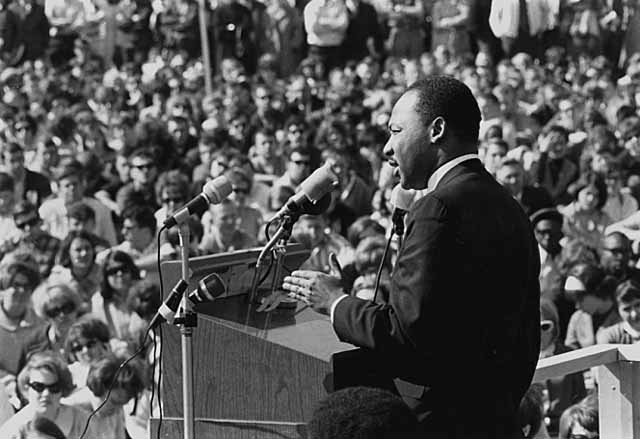Martin Luther King, Jr. studied the writings of Mahatma Gandhi during his student days, and realised that Gandhi’s methods of non-violent resistance were the correct tools to use to gain civil rights for poor minorities. To those who accused him of causing trouble, King replied that the downtrodden and mistreated people can only get justice and peace by agitating non-violently until their grievances were redressed.
The Montgomery bus boycott of 1955-1956 gave the Reverend King his first chance to practice non-violent resistance to unjust laws. Rosa Parks, a black seamstress and civil rights activist, refused to give up her seat in the bus to a white passenger, which was required by the law in the South at that time. For this she was arrested and summoned to court. The black citizens of Montgomery, Alabama decided to boycott the buses for one day. This boycott proved to be so successful that they continued it. They refused to ride the buses at all until they were given what they considered to be civil rights under the law. All they asked for was courteous treatment from the bus drivers, and an end to segregated seating in the buses.
Dr King was named the leader of this boycott. During the 382-day ordeal, he succeeded in getting his people to walk, ride mules or bikes, and to car-pool, but never to ride the bus to work, school or play. During this time, Dr King was harassed, imprisoned, and humiliated. His home was even bombed, but he never retaliated physically. He taught his followers to use peace, not violence, to win their battles. The highest court in the land, the Supreme Court, finally heard the case, and decided that the cause was just. The buses of Montgomery were finally integrated.
He helped organise the 1963 nonviolent protests in Birmingham, Alabama and the 1963 March on Washington, where he delivered his famous “I Have a Dream” speech.
On October 14, 1964, King received the Nobel Peace Prize for combating racial inequality through nonviolence. In 1965, he helped to organize the Selma to Montgomery marches, and the following year he and SCLC took the movement north to Chicago to work on segregated housing. In the final years of his life, King expanded his focus to include poverty and speak against the Vietnam War.
In 1968, King was planning a national occupation of Washington, D.C., to be called the Poor People’s Campaign, when he was assassinated on April 4 in Memphis, Tennessee. His death was followed by riots in many U.S. cities.
SIX STEPS OF NONVIOLENT SOCIAL CHANGE (The King Centre)
The Six Steps for Nonviolent Social Change are based on Dr. King’s nonviolent campaigns and teachings that emphasize love in action. Dr. King’s philosophy of nonviolence, as reviewed in the Six Principles of Nonviolence, guide these steps for social and interpersonal change.
- INFORMATION GATHERING:To understand and articulate an issue, problem or injustice facing a person, community, or institution you must do research. You must investigate and gather all vital information from all sides of the argument or issue so as to increase your understanding of the problem. You must become an expert on your opponent’s position.
- EDUCATION:It is essential to inform others, including your opposition, about your issue. This minimizes misunderstandings and gains you support and sympathy.
- PERSONAL COMMITMENT: Daily check and affirm your faith in the philosophy and methods of nonviolence. Eliminate hidden motives and prepare yourself to accept suffering, if necessary, in your work for justice.
- DISCUSSION/NEGOTIATION: Using grace, humor and intelligence, confront the other party with a list of injustices and a plan for addressing and resolving these injustices. Look for what is positive in every action and statement the opposition makes. Do not seek to humiliate the opponent but to call forth the good in the opponent.
- DIRECT ACTION: These are actions taken when the opponent is unwilling to enter into, or remain in, discussion/negotiation. These actions impose a “creative tension” into the conflict, supplying moral pressure on your opponent to work with you in resolving the injustice.
- RECONCILIATION: Nonviolence seeks friendship and understanding with the opponent. Nonviolence does not seek to defeat the opponent. Nonviolence is directed against evil systems, forces, oppressive policies, unjust acts, but not against persons. Through reasoned compromise, both sides resolve the injustice with a plan of action. Each act of reconciliation is one step close to the ‘Beloved Community.’
Based on Martin Luther King, Jr.’s “Letter from Birmingham Jail” in Why We Can’t Wait, Penguin Books, 1963.










